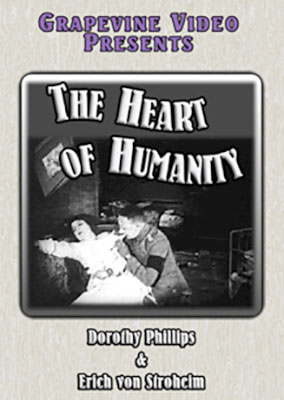The Heart of Humanity, (1918)
Director: Allen Holubar
Men played a big role in World War I, but women also played an important role during World War I. Foner discusses the responsibilities that women took on while the men were at war, this was also shown in the movie, Heart of Humanity. Foner mentions how women went off to help during war by becoming nurses to aid those who were injured. The character of Nanette in the movie closely relates to this because she also gave up her responsibilities in her own home. She left her child in order to help others and become a nurse. Foner states, "Under the Selective Service Act of May 1917, 24 million men were required to register with the draft, and the army soon swelled from 120,000 to 5 million men" (Foner 727). Nationalism was a huge deal during this time as the citizens of the United States all helped as much as they could and showed patriotism for their country. The movie had a great example of this, the Patricia household had five sons in this movie, all were drafted into the war and traveled overseas to support and protect their country.
Q2. How are female roles represented in the film? Does WWI require a "new" type of woman?
Females in this movie are represented as much more independent. With the men off fighting in the war women had to take on many of the responsibilities that men would have. In the movie with Nanette's husband was overseas, and she is at home with her mother-in-law, Louis who is John's youngest brother, and her son. As time goes on, Nanette decides to join the red cross to aid those soldiers who were injured during war and care for the refugee children as she hears about the troubles that they face. She sacrifices her own child and leaves him behind to be raised by her mother-in-law. World War I definitely requires a new type of woman. Woman gained more freedom during this time as they have learned to take care of the household and help others in need during the war. Nanette was depicted as a strong, determined woman.
Q6. What would an audience think of Germans after viewing this film?
In this film, Germans were viewed as villains and portrayed as being bad. One scene in this movie that proves this point was when Lieutenant Eric von Stroheim attacks Nanette attempting to rape her, he also throws a crying baby out the window. As a result of his actions Nanette stabs herself with a knife, hoping to commit suicide before he could do anything to her. Since Lieutenant Eric von Stroheim acted in a atrocious manner, this behavior was generalized with all Germans. Germans were displayed as corruptive and grievous in this film. Lieutenant Eric von Stroheim caused damage to the main character in this film, which poses a negative view towards him from the audience perspective due to his behavior.
Q7. What does the film reveal about American culture during WWI?
American culture during this time was tied together quite strongly. Foner and the film both display the nationalism that was shown by the citizens of the United States. Men and Women worked together to fight for their country. The film showed the majority of all men were off fighting in the war, and Patricia's family all of her sons were fighting and supporting the war during some part of the film. This shows that people really cared for their country. This movie also shows that men were a lot more dependent and believed women more than they ever had, leaving their family responsibilities and the children to their wives. World War I showed women coming closer towards more freedom during this time.
Review
I would give this film a 4 out of 5 because I think it gave the audience a really good idea of World War I and it's effects. I appreciated this film a lot more than I would have because it is a silent film, which makes it harder to get the point across, especially to an audience during the 21st century but this film was successful in doing so. At some points it was difficult to understand what characters were trying to communicate to each other but overall it was directed very well.
Worked Cited
Foner, Eric. "Safe for Democracy: The United States and World War I 1916-1920." Give Me Liberty!: An American History. 3rd ed. New York: W.W. Norton, 2012. Print.
The Heart of Humanity. Dir. Allen Holubar. Released through Jewel Productions, 1918. DVD.

